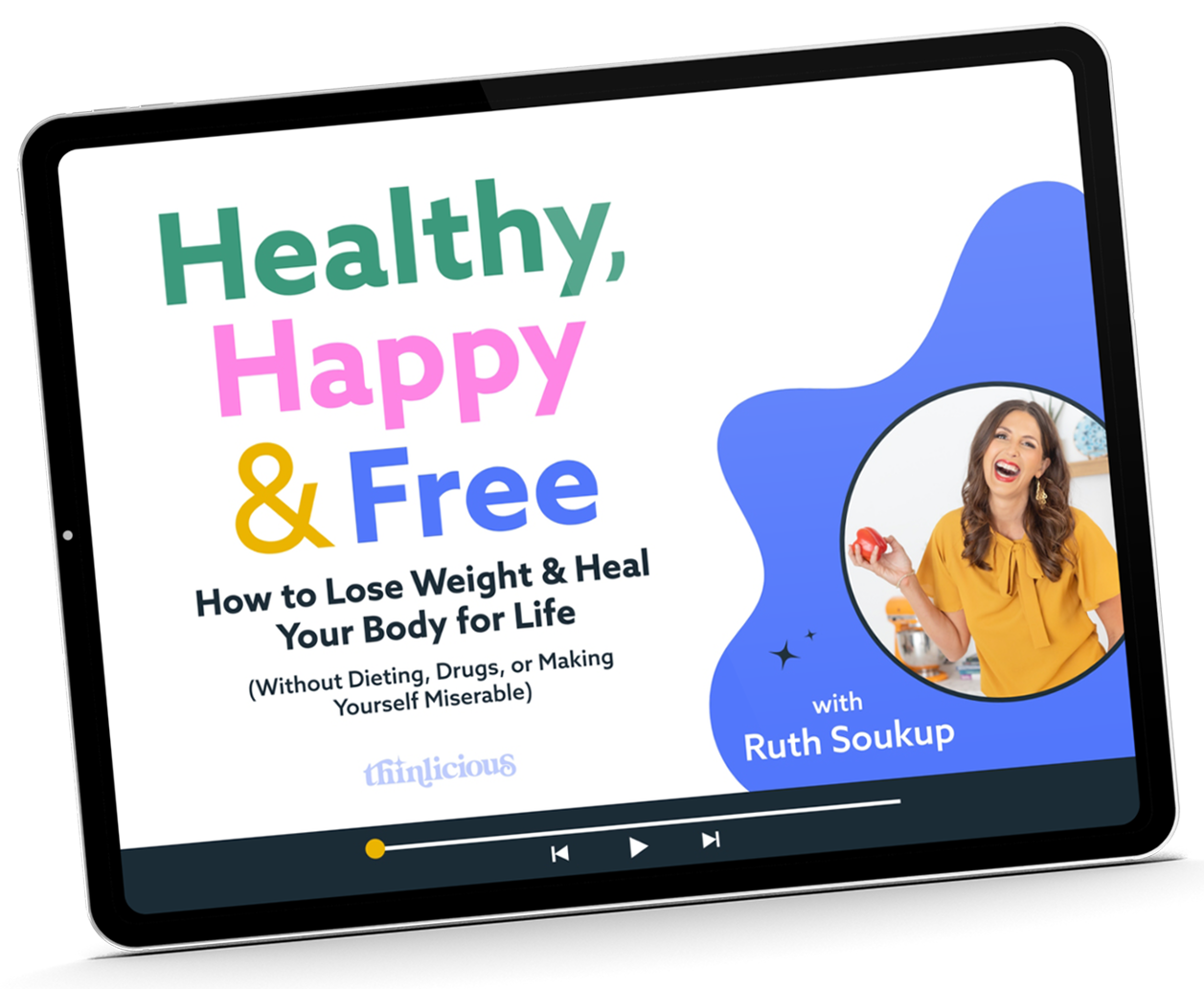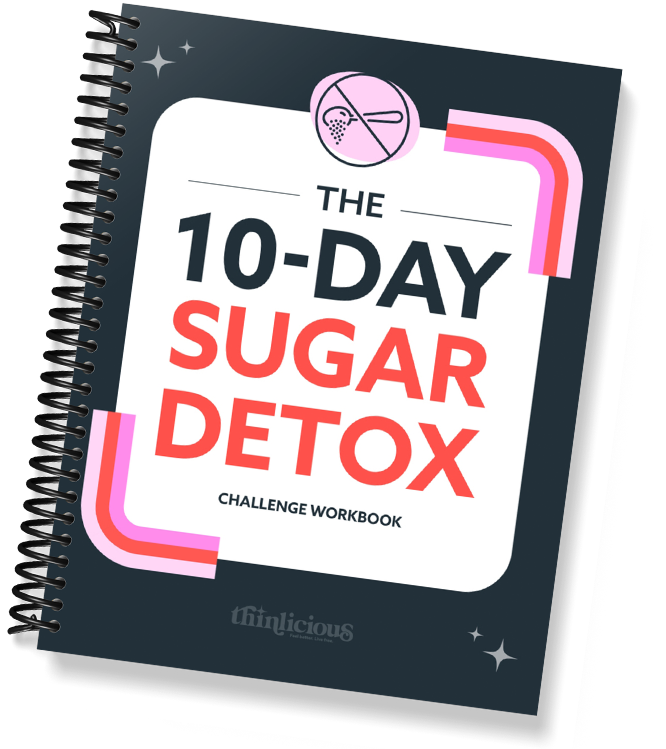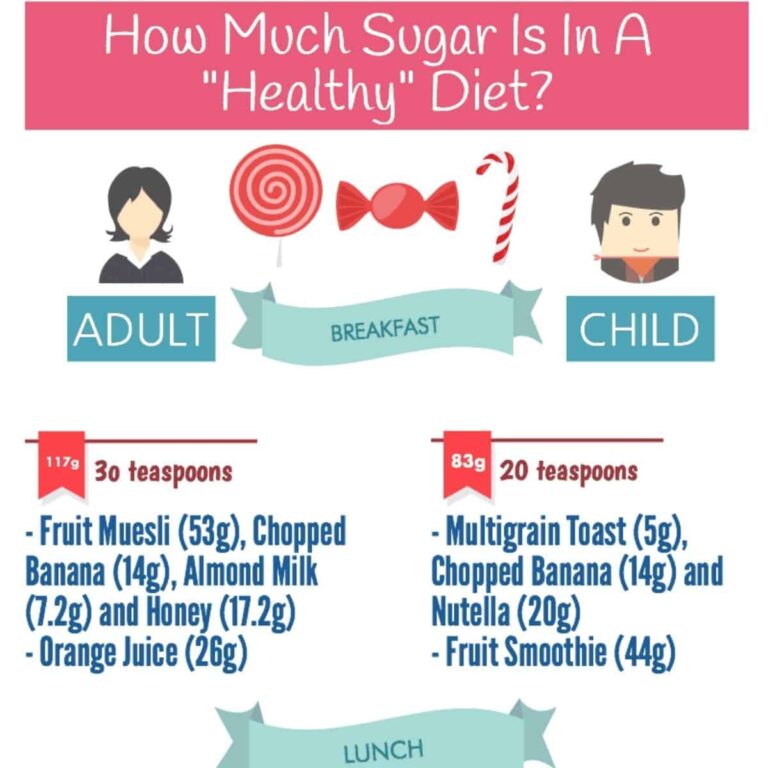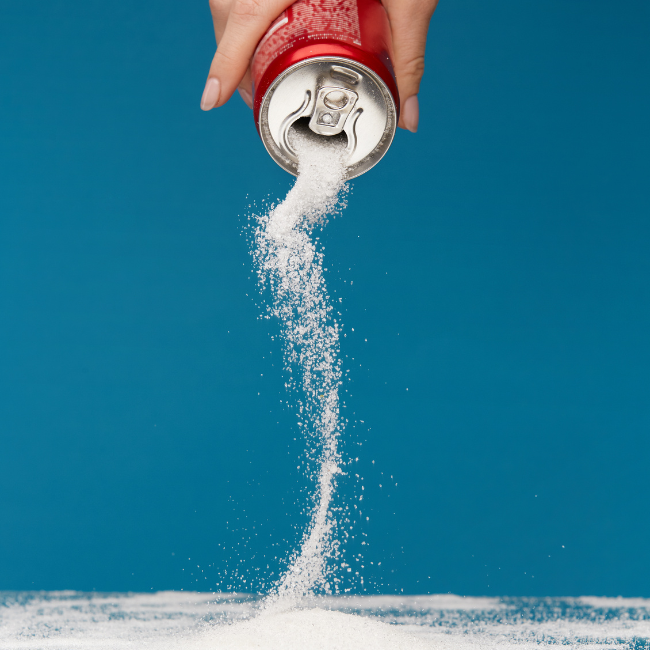So you’re finally ready to get serious about getting healthy and losing weight. Maybe it was seeing yourself in that last family photo. Maybe it’s no longer fitting into your favorite pair of jeans. Or maybe you just don’t feel good a lot of the time. You’re tired. Your joints ache. Your skin is dull.
You know there has to be a better way.
But every time you turn around, it feels like some so-called diet expert is saying something different. One minute you’re hearing about the dangers of fat, the next you’re being told to eat more fat. One day it’s popular to count calories, the next you’re hearing how there are things called “empty calories.” Eat plant based. No, eat like a carnivore. Whole grains are heart healthy. No, stay away from gluten! Add more fiber. No, just focus on protein!
Let’s be honest; if there is one space that feels almost impossible to navigate safely, it’s the diet space.
Are you ready to lose weight and heal your body for life (without dieting, drugs, or making yourself miserable)?

Our free on-demand video training will walk you through how to make this THE year you set health goals…and keep them.
And to top it off, everything you’ve heard about things like keto and paleo and low-carb diets seems to be even more contradictory, with some people claiming that carbs are the root cause of everything from Type 2 diabetes and autoimmune disease to cancer and infertility, while others argue that eating a steady diet of nothing but bacon and butter can’t possibly be good for you.
So it begs the question, doesn’t it?
Are low-carb and ketogenic diets safe, especially long term?
Is cutting out sugar and carbohydrates really the magic bullet that so many people claim, or are there hidden dangers that need to be factored in?
And will a low-carb diet work for everyone?
You’re smart to question things, and we’re glad your search brought you here. Because here at Thinlicious™, we believe in using science and real research from well-documented, double-blind studies to make our decisions, and that is what our program is based on.
But as you search and wonder, let’s just start with the short answer.
Low-carb eating is completely healthy and safe, especially if you do it the right way.
Keep reading, and we’ll look at the most common safety questions about low-carb eating and how to eat low carb, high fat food that supports your health and could even help you live longer.

Are Low-Carb Diets Safe?
The short answer is that, yes, eating low carb is completely safe. So why is there so much anxiety around it?
The fear around the safety of low-carb, ketogenic-style diets is largely due to a study published in Poland, so let’s look at that study and see what they found.
In 2018, Professor Maciej Banach, of the Medical University of Lodz, Poland, conducted a study on the risks associated with eating a low-carb diet long term. His team stated that “people who consumed a low-carbohydrate diet were at greater risk of premature death.”
Woah. Those are scary words. Greater risk of premature death? Why?
Well, Professor Banach clarified his findings by saying, “Low-carbohydrate diets might be useful in the short term to lose weight, lower blood pressure and improve blood glucose control, but our study suggests that in the long term they are linked with an increased risk of death from any cause.”
See? All that misinformation was over one statement from his study, without considering how he clarified it. Low-carb diets lower blood pressure and improve blood glucose control—two essential things to reducing your risk for diabetes and heart disease (which are killing older adults).
It’s also important to note that if you look closely at his team’s study, you’ll realize it doesn’t reflect today’s updated and safer low-carb diets. Their survey only included participants from 1999-2010.
This is why the Thin Adapted System™ happens in three phases. First, your body needs to adapt to burning fat for energy instead of carbs. But you aren’t supposed to stay in Phase 1 forever. You’ll move on to Phase 2 (when the most fat burning happens) and eventually to Phase 3, when you maintain a healthy lifestyle and can even incorporate some of those low-glycemic carbs you’ve been abstaining from for a while.
If you adjust the food you eat as you go through each of the phases, a low-carb, high-fat, high-protein diet helps you eliminate obesity, prevent insulin resistance and actually lower your risk for heart disease.
Eating low carb is completely safe, but you still have to monitor your body and adjust as the needs arise.
That’s why you should listen to your body and make changes if you notice any funky health reactions you might be feeling.
Those funky health reactions are the dangers we’ll discuss next.
6 Things To Watch Out For On Low Carb
As you move through the three phases in our Thin Adapted System, your body will undergo all sorts of changes, and in our curriculum, we share, week by week, what to monitor and how to adjust your eating habits if you notice any warning signs. If you haven’t joined our program, get started with the 28 Day Metabolism Reset!
Everyone’s body is completely unique. Remember, please contact your doctor if you have any specific health concerns. This guide is more of an overview of things you should know before you begin. It’s not meant to diagnose or treat anything and is not medical advice.
Since this is a general overview, it will cover some common issues that some people have experienced during the various phases of their low-carb journey.
That said, most of these issues are very rare, so do not be concerned that this is what you are facing as you switch to a low-carb lifestyle.
Keto Flu
Have you heard of the keto flu? No matter what the name implies, it has nothing to do with actual influenza.
The keto flu actually describes how some people can feel sick when they start eating low carb. This happens because the body is changing how it burns fuel for energy. Some people might have a headache, feel tired or have trouble sleeping. You don’t need to worry, though—it is temporary, and the solution is to just drink lots of fluids and eat foods with salt.
Yup, if you’re feeling lethargic, your probably need to drink more electrolytes—which leads to the next thing some people experience.
Dehydration
When you change the way you eat, it’s easier for your body to become dehydrated, so drink lots of water!
Here’s another fun side effect of your body producing ketones. Not only do these little ketones eat up fat for energy, but they act like a diuretic, too. This means you’ll pee more often, which naturally leads to fewer fluids in your body.
Not only that, but the liver also releases glycogen, which also exits the body through urine. This is why some people refer to the weight they lose in Phase 1 as “water weight.”
Losing all that water weight comes with the potential consequence of dehydration , so drink up as much water as you can.
A very common symptom of dehydration is constipation too, and when you’re eating a lot of dairy, getting stopped up could happen.
Constipation
Eating right should make you feel better. Constipation is the opposite of feeling better. Take a peek at some typical keto meal plans and you might think, “Wow, that is a LOT of cheese. Are they even pooping?” HA!
Constipation is something else some people experience when they follow a low-carb plan. Thankfully, this one is really easy to prevent! All you have to do is eat low-carb, high-fiber foods.
This includes things like low-carb veggies (asparagus, cauliflower, broccoli) and high-fiber seeds like chia seeds.
When you follow the macros correctly in the Thin Adapted System, you won’t have a problem with constipation.
Constipation can be painful, but not as painful as the next (rare) thing.
Kidney Stones
Just like with constipation, you’re more likely to get kidney stones if you aren’t eating the correct amount of fiber and fat. Some people who don’t eat the correct ratio of macronutrients could get kidney stones.
As healthy as animal protein is for you, (and as much as we enjoy a protein fast day or two), you can’t live forever on just animal protein all the time. Studies show that too much of it can cause your urine to become too acidic, which leads to more calcium in it. And that calcium is exactly where kidney stones come from.
Your body needs a balance of nutrients to function properly.
Even though it’s unlikely that eating low carb will give you kidney stones, it’s a good reminder to track your macros and prevent them from even possibly happening. They are PAINFUL!
Nutrient Deficiencies
Another thing to watch out for when you eat low carb is getting all your nutrients, vitamins and minerals. Whenever you eliminate an entire food group, you risk losing out on all those wonderful health benefits—unless you replace them with something else.
With low carb, people worry that if they cut out whole grains, they will miss out on that fiber. Even though that’s partly true, it’s more of a reminder and motivation to eat more low-carb vegetables.
You don’t need to get fiber from whole grains. But you do need to remember to get it from somewhere, so make some roasted cauliflower or beef and broccoli. Your body needs it.
Ketoacidosis – What even is that?!!
Finally, some people worry that eating low carb could lead to something called ketoacidosis. But it’s rare, and really only happens to people who have Type 1 diabetes.
Diabetic ketoacidosis is a serious complication of diabetes, but people often confuse it with ketosis, which is completely different and actually a good thing!
Diabetic ketoacidosis (DKA) happens when someone’s body can’t produce enough insulin. In this state, the body begins to produce too many blood acids.
Ketoacidosis is not a metabolic process (and ketosis is). It’s a complication that happens in the body when it has too many ketones and glucose. This often happens because the body isn’t producing insulin, which is why it’s a complication of diabetes, usually Type 1.
This is not the same thing as ketosis. Ketosis is a metabolic state the body goes into when it doesn’t have enough glycogen from carbohydrates to burn as energy, producing ketones that burn fat for energy.
Ketosis lowers high insulin levels, which then adjusts all the other hormones in your body at the same time. This is one of the best (and safest) things you can do for your health. We go into a lot more detail about this in our guide that explains how Thinlicious compares to a keto diet.
Is Low-Carb Safe If You Have Autoimmune Disorders?
Here’s the thing. If you have a serious health concern, you need to speak with your doctor before changing how you eat.
Generally speaking, (and that’s as close as we’ll get when it comes to medical stuff), eating low carb can help your body reduce inflammation. Many (but not all) autoimmune disorders start to show fewer symptoms when the body isn’t as inflamed.
Definitely schedule a chat with your physician and ask how safe it is for you and your exact health disorder.
Alzheimer’s & Keto
On the other hand, there are a lot of studies out there showing not only the safety of keto on Alzheimer’s Disease (AD), but that it could either help prevent it or reduce the symptoms.
One study showed improved daily function in adults with AD. Another study showed improved cognitive performance in adults with AD, especially pre-symptomatic (before they start showing obvious signs of AD). Even though this study concludes that more research should be done, it also found that a keto diet lowers the risk of depression and anxiety in adults with AD too.
AD is continuing to be studied and researched, so new information is constantly being released. That’s why it’s important to talk to your doctor if you want to use a diet change in conjunction with other treatment plans.
How To Monitor Your Ketones
Whether you’re doing it to reduce inflammation, prevent AD, lose weight or just feel better, the most accurate way to eat low carb is to monitor how your body responds to being Thin Adapted.
And you do this by tracking your ketone levels. There are devices that will do this for you in seconds. There are strips you pee on, machines you breathe into and devices that test your blood. In fact, we have an entire guide to keto and glucose testing.
We recommend using Keto Mojo. This little device tracks both your blood glucose and your ketone levels, so you scientifically see how your body is responding to the food you’re eating
The Keto Mojo works just like other diabetic blood glucose tests. You prick a finger with the lancet and use the kit and strips to see your levels. It even syncs via Bluetooth to an app on your phone so you can keep track of your body’s reactions.
Their blog has a lot of informational articles explaining how to use their products and how to interpret the results. Browse their website and get a ketone tracker ; it takes the guesswork out of how your body responds to Thinlicious.
Keep Reading
Here at Thinlicious, we believe you should constantly learn about how your body works and how it affects weight loss. Here are some books that we recommend that will tell you even more about the safety of eating low carb.
- The Obesity Code By: Dr. Jason Fung, MD
- The Keto Code By: Dr. Steven R. Gundry
- The Grain Brain By: David Perlmutter
Final Thoughts
See, eating low carb is safe and even good for you. Just like everything else in life, for it to be safe, you have to do it correctly. Eat enough of the important micronutrients, track your ketones and listen to your body when it isn’t responding very well. We know you can finally look and feel better…without feeling crummy.
Get Started
Are you ready to take control of your health and feel better for good? Then start with our Thinlicious 28 Day Metabolism Reset, designed to introduce you to the Thin Adapted System and help you retrain how your body burns fuel in just four weeks. Get it HERE.
PIN FOR LATER

What if you could actually take control of
your health in just 10 days?
It’s not your fault you can’t lose weight as a woman over 40 even though you’ve likely tried literally everything. Your metabolism probably feels broken and your hormones are likely all out of whack.
But you can fix it all with ONE simple change: eliminate sugar. We make it super easy with daily lessons teaching you the science behind what makes us gain weight in our midlife and beyond! Are you ready to get started now?











